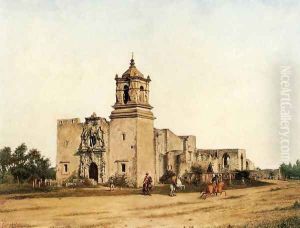Theodore Gentilz Paintings
Theodore Gentilz was a French-born artist, recognized primarily for his detailed depictions of the landscapes, peoples, and customs of early Texas. Born on October 22, 1819, in Paris, France, Gentilz studied art under the notable French landscape painter, Jean-Baptiste-Camille Corot. His artistic talent was apparent from an early age, and he received a solid foundation in the principles of landscape painting and classical art traditions.
In 1844, Gentilz's life took a significant turn when he was hired by Henri Castro, a French empresario, to serve as a surveyor and artist for Castro's colony in Texas. Leaving France behind, Gentilz embarked on a new life in the United States, which would deeply influence his artistic career. Once in Texas, he settled near San Antonio and over the years, became intimately acquainted with the region's landscape, its inhabitants, including the local Mexican population, Native Americans, and the early settlers.
Gentilz's work is notable for its ethnographic accuracy and attention to detail. He was a meticulous observer of the world around him, and his paintings often serve as historical records of the people, architecture, and customs of 19th-century Texas. His landscapes are imbued with a sense of place that goes beyond mere representation; they capture the atmosphere and the particularities of the frontier life. Gentilz also taught art and may be considered one of the early art educators in Texas, passing on his knowledge and skills to a new generation of artists.
Theodore Gentilz continued to paint and teach throughout his life. He became an important figure in the Texas art community and contributed significantly to the cultural heritage of the state. His works are now considered invaluable for their historical and cultural significance, providing insight into an era that shaped the identity of Texas. Gentilz died on January 4, 1906, in San Antonio, Texas, but left behind a rich legacy through his art, which continues to be celebrated and studied for its depiction of a formative period in Texas history.
